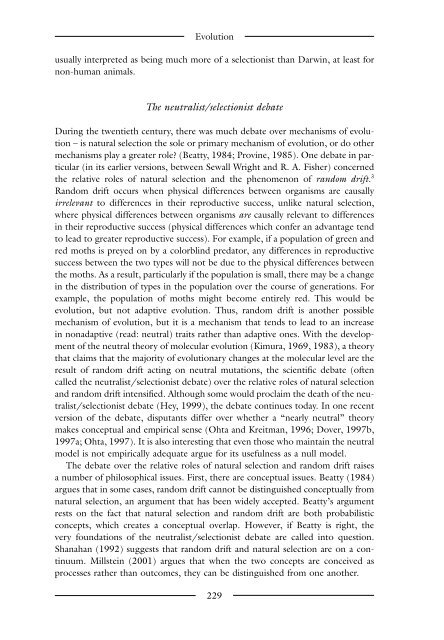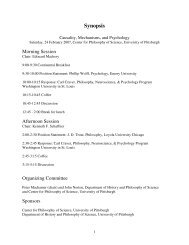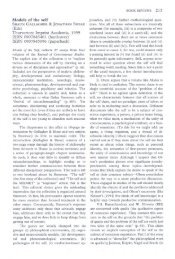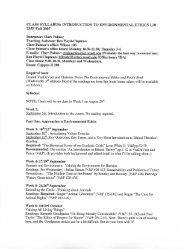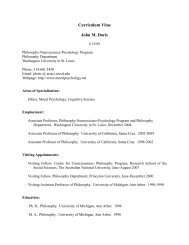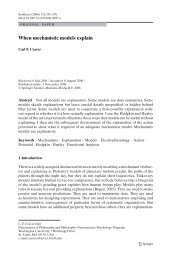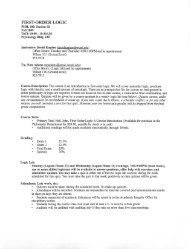The Blackwell Guide to the Philosophy of Science - The Department ...
The Blackwell Guide to the Philosophy of Science - The Department ...
The Blackwell Guide to the Philosophy of Science - The Department ...
You also want an ePaper? Increase the reach of your titles
YUMPU automatically turns print PDFs into web optimized ePapers that Google loves.
Evolution<br />
usually interpreted as being much more <strong>of</strong> a selectionist than Darwin, at least for<br />
non-human animals.<br />
<strong>The</strong> neutralist/selectionist debate<br />
During <strong>the</strong> twentieth century, <strong>the</strong>re was much debate over mechanisms <strong>of</strong> evolution<br />
– is natural selection <strong>the</strong> sole or primary mechanism <strong>of</strong> evolution, or do o<strong>the</strong>r<br />
mechanisms play a greater role? (Beatty, 1984; Provine, 1985). One debate in particular<br />
(in its earlier versions, between Sewall Wright and R. A. Fisher) concerned<br />
<strong>the</strong> relative roles <strong>of</strong> natural selection and <strong>the</strong> phenomenon <strong>of</strong> random drift. 3<br />
Random drift occurs when physical differences between organisms are causally<br />
irrelevant <strong>to</strong> differences in <strong>the</strong>ir reproductive success, unlike natural selection,<br />
where physical differences between organisms are causally relevant <strong>to</strong> differences<br />
in <strong>the</strong>ir reproductive success (physical differences which confer an advantage tend<br />
<strong>to</strong> lead <strong>to</strong> greater reproductive success). For example, if a population <strong>of</strong> green and<br />
red moths is preyed on by a colorblind preda<strong>to</strong>r, any differences in reproductive<br />
success between <strong>the</strong> two types will not be due <strong>to</strong> <strong>the</strong> physical differences between<br />
<strong>the</strong> moths. As a result, particularly if <strong>the</strong> population is small, <strong>the</strong>re may be a change<br />
in <strong>the</strong> distribution <strong>of</strong> types in <strong>the</strong> population over <strong>the</strong> course <strong>of</strong> generations. For<br />
example, <strong>the</strong> population <strong>of</strong> moths might become entirely red. This would be<br />
evolution, but not adaptive evolution. Thus, random drift is ano<strong>the</strong>r possible<br />
mechanism <strong>of</strong> evolution, but it is a mechanism that tends <strong>to</strong> lead <strong>to</strong> an increase<br />
in nonadaptive (read: neutral) traits ra<strong>the</strong>r than adaptive ones. With <strong>the</strong> development<br />
<strong>of</strong> <strong>the</strong> neutral <strong>the</strong>ory <strong>of</strong> molecular evolution (Kimura, 1969, 1983), a <strong>the</strong>ory<br />
that claims that <strong>the</strong> majority <strong>of</strong> evolutionary changes at <strong>the</strong> molecular level are <strong>the</strong><br />
result <strong>of</strong> random drift acting on neutral mutations, <strong>the</strong> scientific debate (<strong>of</strong>ten<br />
called <strong>the</strong> neutralist/selectionist debate) over <strong>the</strong> relative roles <strong>of</strong> natural selection<br />
and random drift intensified. Although some would proclaim <strong>the</strong> death <strong>of</strong> <strong>the</strong> neutralist/selectionist<br />
debate (Hey, 1999), <strong>the</strong> debate continues <strong>to</strong>day. In one recent<br />
version <strong>of</strong> <strong>the</strong> debate, disputants differ over whe<strong>the</strong>r a “nearly neutral” <strong>the</strong>ory<br />
makes conceptual and empirical sense (Ohta and Kreitman, 1996; Dover, 1997b,<br />
1997a; Ohta, 1997). It is also interesting that even those who maintain <strong>the</strong> neutral<br />
model is not empirically adequate argue for its usefulness as a null model.<br />
<strong>The</strong> debate over <strong>the</strong> relative roles <strong>of</strong> natural selection and random drift raises<br />
a number <strong>of</strong> philosophical issues. First, <strong>the</strong>re are conceptual issues. Beatty (1984)<br />
argues that in some cases, random drift cannot be distinguished conceptually from<br />
natural selection, an argument that has been widely accepted. Beatty’s argument<br />
rests on <strong>the</strong> fact that natural selection and random drift are both probabilistic<br />
concepts, which creates a conceptual overlap. However, if Beatty is right, <strong>the</strong><br />
very foundations <strong>of</strong> <strong>the</strong> neutralist/selectionist debate are called in<strong>to</strong> question.<br />
Shanahan (1992) suggests that random drift and natural selection are on a continuum.<br />
Millstein (2001) argues that when <strong>the</strong> two concepts are conceived as<br />
processes ra<strong>the</strong>r than outcomes, <strong>the</strong>y can be distinguished from one ano<strong>the</strong>r.<br />
229


